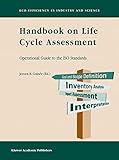Handbook on life cycle assessment: operational guide to the ISO standards [Libro electrónico] / Jeroen B. Guinee
Guinee, Jeroen B [editor].
Tipo de material: Libro
en línea Series Editor: Boston: Kluwer Academic Publishers, c2002Descripción: xi, 692 páginas : ilustraciones ; 27 centímetros.ISBN: 1402002289; 9781402002281; 9780306480553.Tema(s): Industrial ecology -- Handbooks, manuals, etc | Product life cycle -- Environmental aspects -- Handbooks, manuals, etcNota de acceso: Disponible para usuarios de ECOSUR con su clave de acceso Nota de bibliografía: Incluye bibliografía Número de sistema: 54897Contenidos:Mostrar
Resumen:
Libro
en línea Series Editor: Boston: Kluwer Academic Publishers, c2002Descripción: xi, 692 páginas : ilustraciones ; 27 centímetros.ISBN: 1402002289; 9781402002281; 9780306480553.Tema(s): Industrial ecology -- Handbooks, manuals, etc | Product life cycle -- Environmental aspects -- Handbooks, manuals, etcNota de acceso: Disponible para usuarios de ECOSUR con su clave de acceso Nota de bibliografía: Incluye bibliografía Número de sistema: 54897Contenidos:Mostrar
Resumen:| Tipo de ítem | Biblioteca actual | Colección | Signatura | Estado | Fecha de vencimiento | Código de barras |
|---|---|---|---|---|---|---|
| Libros | Biblioteca Electrónica Recursos en línea (RE) | Acervo General | Recurso digital | ECO400548972207 |
Incluye bibliografía
Part 1: LCA in perspective.. 1. Why a new Guide to LCA?.. 2. Main characteristics of LCA.. 3. International developments.. 4. Guiding principles for the present Guide.. 5. Reading guide.. Part 2a: Guide.. Reading guidance.. 1. Management of LCA projects: procedures.. 2. Goal and scope definition.. 3. Inventory analysis.. 4. Impact assessment.. 5. Interpretation.. Appendix A: Terms, definitions and abbreviations.. Part 2b: Operational annex.. List of tables.. Reading guidance.. 1. Management of LCA projects: procedures.. 2. Goal and scope definition.. 3. Inventory analysis.. 4. Impact assessment.. 5. Interpretation.. 6. References.. Part 3: Scientific background.. Reading guidance.. 1. General introduction.. 2. Goal and scope definition.. 3. Inventory analysis.. 4. Impact assessment.. 5. Interpretation.. 6. References
Disponible para usuarios de ECOSUR con su clave de acceso
Environmental policy aims at the transition to sustainable production and consumption. This is taking place in different ways and at different levels. In cases where businesses are continuously active to improve the environmental performance of their products and activities, the availability of knowledge on environmental impacts is indispensable. The integrated assessment of all environmental impacts from cradle to grave is the basis for many decisions relating to achieving improved products and services. The assessment tool most widely used for this is the environmental Life Cycle Assessment, or LCA. Before you is the new Handbook of LCA replacing the previous edition of 1992. New developments in LCA methodology from all over the world have been discussed and, where possible, included in this new Handbook. Integration of all developments into a new, consistent method has been the main aim for the new Handbook. The thinking on environment and sustainability is, however, quickly evolving so that it is already clear now that this new LCA Handbook does not embrace the very latest developments. Therefore, further revisions will have to take place in the future. A major advantage of this Handbook is that it now also advises which procedures should be followed to achieve adequate, relevant and accepted results. Furthermore, the distinction between detailed and simplified LCA makes this Handbook more broadly applicable, while guidance is provided as to which additional information can be relevant for specialised applications. eng
Disponible en línea
Disponible en formato PDF
Subscripción a ELSEVIER 26 de diciembre del 2013
